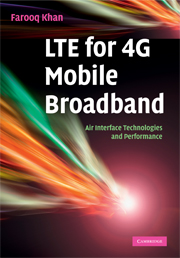Book contents
- Frontmatter
- Contents
- Preface
- 1 Introduction
- 2 Network architecture and protocols
- 3 Downlink access
- 4 Single-carrier FDMA
- 5 Reducing uplink signal peakiness
- 6 Transmit diversity
- 7 MIMO spatial multiplexing
- 8 Channel structure and bandwidths
- 9 Cell search and reference signals
- 10 Random access
- 11 Channel coding
- 12 Scheduling, link adaptation and hybrid ARQ
- 13 Power control
- 14 Uplink control signaling
- 15 Downlink control signaling
- 16 Inter-cell interference control
- 17 Single frequency network broadcast
- 18 Spatial channel model
- 19 LTE performance verification
- Index
15 - Downlink control signaling
Published online by Cambridge University Press: 28 February 2011
- Frontmatter
- Contents
- Preface
- 1 Introduction
- 2 Network architecture and protocols
- 3 Downlink access
- 4 Single-carrier FDMA
- 5 Reducing uplink signal peakiness
- 6 Transmit diversity
- 7 MIMO spatial multiplexing
- 8 Channel structure and bandwidths
- 9 Cell search and reference signals
- 10 Random access
- 11 Channel coding
- 12 Scheduling, link adaptation and hybrid ARQ
- 13 Power control
- 14 Uplink control signaling
- 15 Downlink control signaling
- 16 Inter-cell interference control
- 17 Single frequency network broadcast
- 18 Spatial channel model
- 19 LTE performance verification
- Index
Summary
With the exception of a scheduling request, all uplink control consists of feedback information to support downlink transmissions. The channel quality feedback is provided to support downlink channel-sensitive scheduling and link adaptation. The rank and precoding matrix indication is used for selecting a downlink MIMO transmission format. The ACK/NACK signaling provides feedback on downlink hybrid ARQ transmissions. In contrast to uplink control, the only feedback information on the downlink is ACK/NACK signaling to support uplink hybrid ARQ operation and transmission power control (TPC) commands to support uplink power control. The reason for this asymmetry is simply the fact that both the uplink and the downlink schedulers resides in the eNB. Therefore, the bulk of downlink signaling involves uplink and downlink scheduling grants that convey information on the transmission format and resource allocation for both the uplink and downlink transmissions. In order to support the uplink channel-sensitive scheduling, the uplink channel quality is estimated from the uplink sounding reference signal (SRS).
The three downlink control channels transmitted every subframe are physical control format indicator channel (PCFICH), physical downlink control channel (PDCCH) and physical hybrid ARQ indicator channel (PHICH). The PCFICH carries information on the number of OFDM symbols used for PDCCH. The PDCCH is used to inform the UEs about the resource allocation as well as modulation, coding and hybridARQ control information. Since multiple UEs can be scheduled simultaneously within a subframe in a frequency or space division multiplexed fashion multiple PDCCHs each carrying information for a single UE are transmitted.
- Type
- Chapter
- Information
- LTE for 4G Mobile BroadbandAir Interface Technologies and Performance, pp. 368 - 408Publisher: Cambridge University PressPrint publication year: 2009

